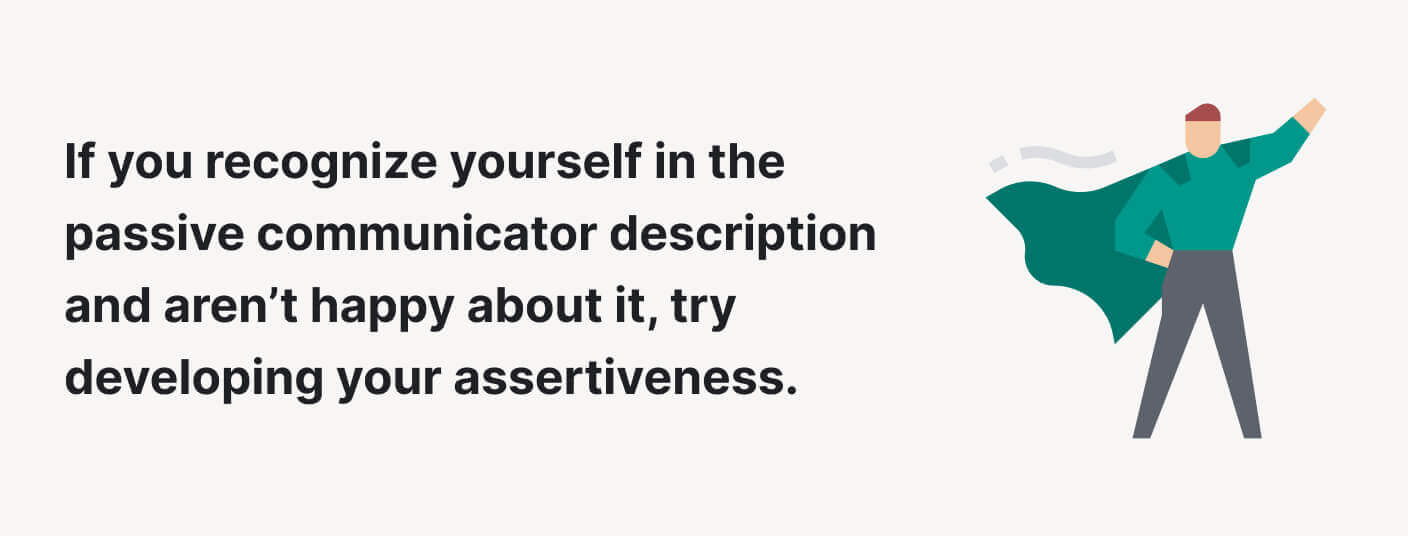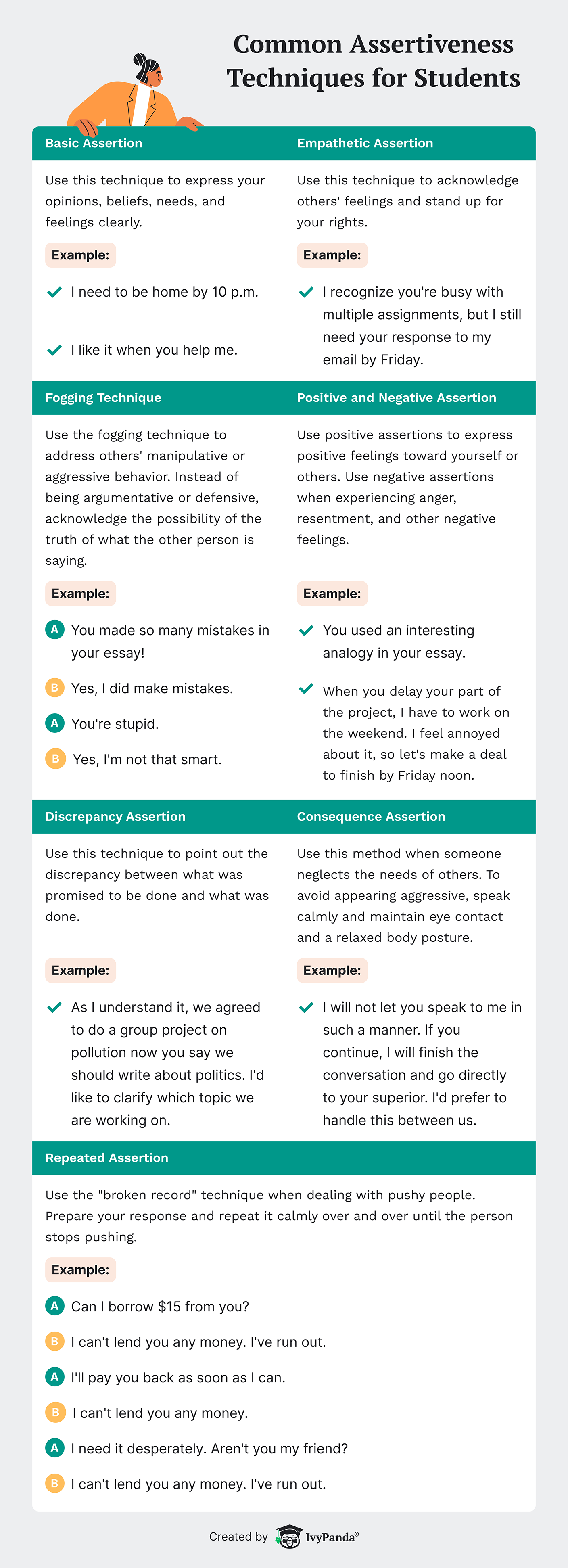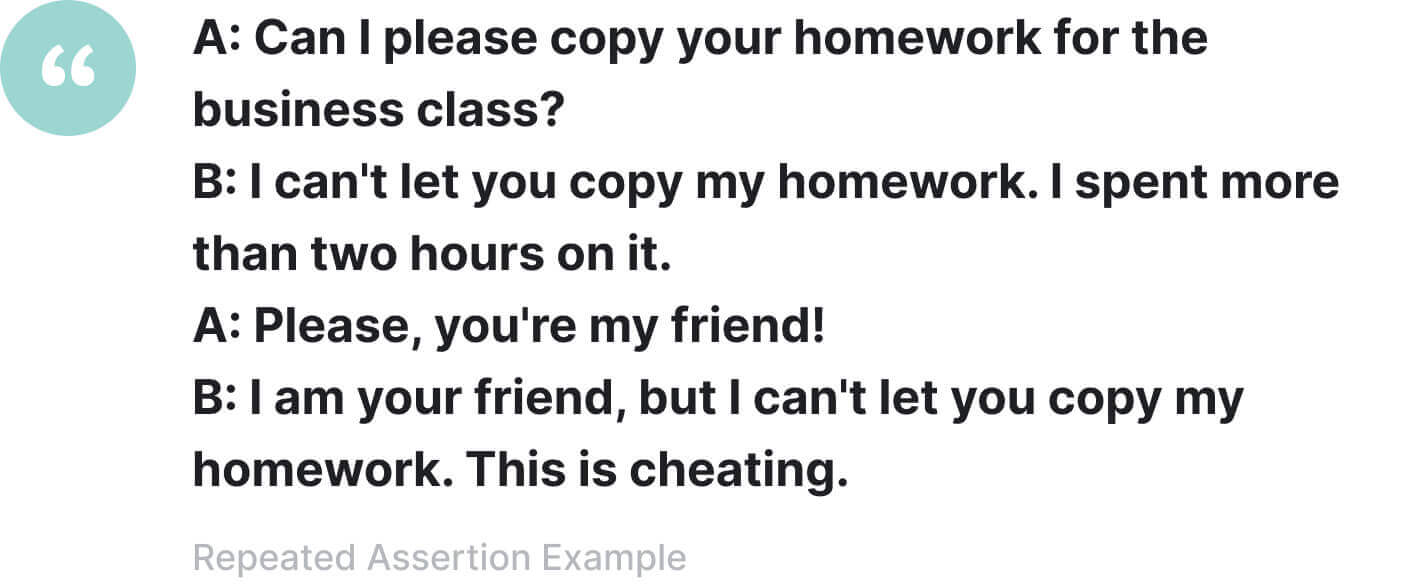Students often deal with stressful situations, criticism, and pressure in college. However, there’s a secret remedy that can help you not to get exhausted. You must know how to stand up for yourself, improve your relationships with peers, and not take things close to heart, you should train your assertiveness.
But what is assertiveness? It is one of the most appreciated communication skills a person can have, and it is no wonder why. Assertiveness helps avoid conflicts, gain self-confidence, and earn respect from others. Assertiveness isn’t an inherited talent; you can master it.

In this article, you’ll find the best tips for boosting assertiveness, even if you’ve always been shy and introverted. And while you’re working on a better version of yourself, check out our essay database, which will make your college life easier!
🔤 Assertiveness Definition
Assertiveness is the social skill of being confident in your opinions without being aggressive toward others. Being assertive means standing up for your own or other people’s rights peacefully and positively without violating personal boundaries.
An assertive person articulates their thoughts and feelings honestly and appropriately. At the same time, this person respects opinions different from their own.
In all your interactions, whether at home or college, with friends or professors, assertiveness can help you express yourself clearly and reasonably without undermining your or others’ rights.
🆚 Assertive Vs. Non-Assertive Communication
Psychologists highlight three communication styles: passive, aggressive, and assertive:
- Passive communicators tend to prioritize other people and their rights. They don’t speak up if they feel like they are mistreated. When passive communicators talk, they often lack eye contact and cannot say “no.”
- Aggressive communicators can violate the rights of others while standing up for their own. Sometimes they do it unconsciously because they are used to this communication style. When speaking, aggressive communicators often use commands and fail to listen to others or consider their feelings.
- Assertive communicators respect their rights and those of other people. Their communication tends to be direct but never offensive or insulting. When communicating, such people express their needs confidently, openly, and positively.
Here’s a comparison of the three communication styles:
Passive Vs. Assertive
A passive communication style is common among young people who avoid expressing their feelings and opinions. Communicators who use this verbal and non-verbal style fear that voicing their concerns may cause conflict. They often feel insecure, as if their needs are less important than the needs of others.

Assertive communicators care about other people’s feelings but never underestimate their own. Individuals using this communication style voice their opinions directly but without insulting others. They have stable self-esteem that helps them protect their boundaries.
Imagine you’re doing a project together with one of your classmates. Suddenly, this person asks if you can finish the assignment alone because they have gotten too busy to complete their share of the work. Here is how passive and assertive communicators would respond to this situation:
- A classical passive response would be: “Yes, no problem.” In reality, however, there is a problem because you both should share the responsibilities. Passive communicators often agree to things they want to say “no” to, putting other people’s comfort above their own.
- An assertive response would be: “No, sorry. I’ve finished my part of the project and have other things to do now. We can discuss your part if you need some advice, but you must do it yourself.” This direct but positive response will show your project partner they cannot pass off their tasks to you.
Aggressive Vs. Assertive
An aggressive communication style drags people into conflicts. Aggressive communicators tend to protect their rights at all costs, often by being overly authoritative and sarcastic. Their behavior is often bossy and arrogant, which pushes other people away.
Assertive communicators also protect their beliefs, but respectfully and transparently. They listen to others and demonstrate interest or concern. They can handle criticism constructively and control their anger in stressful situations.
Imagine yourself suddenly getting a bad grade on the essay you worked hard on. You believe that it wasn’t fair and decide to email your professor. Here is how you might address the situation using aggressive and assertive communication styles:
- An aggressive response would probably contain a text full of rage: “I believe that my essay was perfect and deserves the highest points. Your criteria were too subjective, and I will complain to the administration.” The question remains whether your professor will show understanding and try to help you after such a message.
- A more assertive response would sound like, “Could you please clarify what exactly was wrong in my writing? I worked hard on it and would appreciate your professional feedback.” Respectfully protecting your rights will more likely lead to a positive outcome.
🤔 Why Do Students Lack Assertiveness?
Several reasons stop young people from being assertive. Consider the most common ones:
Family communication patterns
As children, we learn to behave in a way that works for us at the time. If aggressive parents or friends surround us or our assertiveness gets us into trouble, we learn to stay under the radar.
Self-defeating beliefs
Some students have unrealistic and negative assumptions about assertiveness, such as, “It’s rude and selfish to say what I want” or “This will upset others and ruin our relationship.”
Lack of skills
Sometimes we haven’t learned the necessary assertive communication skills, such as active listening, asking for help, saying “no,” etc.
Stress and anxiety
Even though we may know how to be assertive, we might get too anxious or stressed in certain situations. We might fall into aggressive or passive patterns when negative feelings overwhelm us.
Generational and cultural influences
There can be strong cultural influences on our behavior. Cultural values like modesty, sacrifice, and generosity are sometimes preferred over assertiveness.
Negative experiences with peers
Negative past experiences like bullying or fear of rejection might be detrimental to healthy self-esteem and stop people from becoming assertive.
⚖️ Is Being Assertive Good or Bad?
Assertiveness is a valuable communication skill that helps you express your feelings, beliefs, and opinions in a manner that doesn’t violate others’ rights. However, this only works if you slip into aggression. We’ve listed all the benefits of mastering assertiveness as well as the possible threats for you to consider.
Benefits of Being Assertive
Here are some key ways assertive communication benefits you and your daily life:
- It builds confidence. Assertive communication is beneficial in addressing uncomfortable or delicate situations that often occur in college. Using assertive techniques, you will earn the respect of your peers and start communicating more confidently.
- It improves self-esteem. Assertive people tend to have higher self-esteem because they practice self-respect and honor their needs. In other words, assertiveness can enhance our view of ourselves.
- It reduces stress and anxiety. A psychological study conducted in 2016 proved that training assertiveness decreases stress and anxiety, as well as the risks of depression.
- It strengthens relationships. People get attracted to assertive communicators who demonstrate sincere interest and openly share their opinions.
- It helps manage conflicts. A passive communication style might prevent conflict at the moment, but the frustration will keep on growing inside you. Conversely, assertiveness will help you learn to express your opinion honestly and avoid potentially harmful scenarios.
- It protects your needs. Assertiveness allows you to respectfully set boundaries concerning things you don’t feel comfortable doing. Assertive communication lets you express your emotions and boundaries clearly.
Disadvantages of Being Assertive
- One drawback of assertiveness is that it may not be suitable for particular situations. Some individuals may not approve of this communication style and even mistake it for aggression. For example, if you communicate with someone used to taking advantage of easygoing attitudes, they might start acting dominant and rude.
- One more challenge arises when you only start developing your assertiveness. You might be shocked to find out how many people benefited from you being passive and are unhappy about changes. Remember that assertiveness might sometimes not work, but it has long-term profits for your personal, academic, and professional life.

🧑🎓 How to Be More Assertive
Becoming assertive takes practice, but it’s definitely worth the effort. Begin by taking a good look at how you usually communicate. Do you hold back, push too hard, or subtly undermine without even realizing it? Remember, your approach might shift depending on the situation, so keep an eye out for those shifts.
Having identified your general communication approach, you can choose what assertiveness techniques to apply.
How to Be Less Passive and More Assertive
Do you ever notice yourself apologizing too often, avoiding eye contact, or ignoring your instincts when talking to someone? These are signals of a passive communication style in certain situations. If you’re looking to build your confidence and become more assertive, here’s how you can start.
Set Boundaries
The first step is to establish boundaries—clear rules that define how you expect others to treat you. Keep in mind that you are responsible for your own boundaries, while others may have different limits that are beyond your control.
- Identify and verbalize what impacts your comfort level.
- Be honest and transparent with yourself and others.
- Adjust your boundaries depending on the situation.
Setting personal boundaries will help you feel more secure and at ease in your conversations. While some people may feel uncomfortable or challenged by your new limits, you will also discover those who respect and support you as you continue to grow.
Learn to Say “No”
Once you’ve set your boundaries, protecting them means knowing how to say “no” when necessary. Here’s how to handle it:
- Distinguish between what you want to do and what you’re able to do. When asked to take on extra tasks, think about your priorities. You likely have other things that deserve your focus.
- Start your response with a direct “no.” If you want to avoid being persuaded into things, be clear from the beginning. You can briefly explain afterward, but always lead with a straightforward “no.”
- Give a simple and clear reason. If a flat “no” feels too abrupt, offer a concise explanation. This will reinforce your decision and make it less likely to be questioned.
Respect and Express Your Perspective
To become more assertive, you should learn to recognize and verbalize your needs, feelings, and opinions. This might be a challenge if you’ve been underestimating your feelings and putting others before yourself for some time. Our advice is to do the following:
- Find me-time. You can put aside this time to relax and do things you like. Some of the best practices include meditating, doing breathing activities, journaling, and doing your hobbies.
- Start verbalizing your feelings to a friend. This can be any person you trust and can be honest around. Soon you will become more open and direct when communicating with others.
Understand That It’s Not All About You
We often hold ourselves accountable for other people’s emotions. In reality, others’ reactions are out of our control. Being assertive means not trying to please everyone. Look at these tips that will help you stop sabotaging yourself:
- Stop seeking other people’s approval and focus on your self-worth.
- Learn to recognize people’s attempts to control or guilt you.
- Stop trying to help or save people that haven’t asked you to.
- Remember that your emotional health should come first.
Use Confident Body Language
One more helpful strategy is “fake it until you make it.” To become more assertive, you can use powerful body language, which will boost your confidence and attract people. Examples of confident non-verbal behavior include:
- Maintaining eye contact.
- Sitting and standing upright, with your body turned towards the person you speak to.
- Making facial expressions that correspond with your emotions, whether smiling or frowning.
- Staying relaxed, with your arms uncrossed.
Finally, you can always practice in the mirror, which might initially feel silly. However, this will help you gain more control over your body and confidence.
How to Be Less Aggressive and More Assertive
You can easily recognize a person with an aggressive communication style because they tend to speak in a loud and demanding tone. They also generally blame, intimidate, and criticize others. This style can be even more detrimental than a passive one. Luckily, there are some ways to turn your aggression into assertiveness.
Use “I” Statements
One of the distinctive features of aggressive communicators is that they overuse “you” statements. Imagine talking with someone who always says, “You’re wrong!” or “You should’ve taken my advice.” Such comments will negatively impact relationships.
Our first tip to increase your assertiveness is to choose “I” statements to express your feelings and opinions. “I” messages reduce blaming, accusations, and defensiveness, and they also help the listener understand you better.
Ask Questions and Listen
Another tip for becoming more assertive is demonstrating a sincere interest in others. Don’t hesitate to ask questions and take the listener’s position. Doing so can help you better comprehend the perspectives of others and will encourage dialogue.
Besides showing interest, it’s essential to be a good listener. Have a look at these active listening strategies:
- Face the speaker and maintain eye contact.
- Pay attention to non-verbal cues, like body language and facial expressions.
- Listen without judging or jumping to conclusions.
- Don’t start planning what to answer when another person is talking.
Avoid Interrupting
Interrupting is a common habit that negatively influences conversations with other people. Often this is a sign that you’re feeling insecure, concerned about making a good impression, or under a lot of stress. You should stop interrupting if you want to make a positive impression and reach agreements in your interactions with people. Consider these helpful tips:
- Try slowing down the conversational pace if you speak fast or ramble.
- Listen for the meaning behind another person’s words and stay focused.
- Learn to notice your urges to interrupt and try to resist them.
- Wait for a pause in a conversation or ask for a turn to talk.
Be Honest but Considerate
There’s no place for anger in assertive communication. However, that doesn’t mean you should suppress your feelings. The idea behind assertiveness is that you verbalize your boundaries directly but respectfully.
If you want to express your anger or criticism assertively, try the following tips:
- Recognize the physical signs of your anger, such as tightness in your chest, tense muscles, or sweating.
- Think before speaking. Take your time to formulate an answer in your mind.
- Focus on the problem, not the person.
- Talk about what angered you clearly and objectively.
- Tell the person how you feel using “I” statements.
- Take a break and finish a conversation later if your emotions are overwhelming.
Be Aware of Your Body Language and Tone
Posture, eye contact, and hand gestures greatly influence others’ perceptions of you. You should observe your body language to break the aggressive pattern and improve your assertiveness. Let’s compare the physical manifestations of an aggressive and assertive communicator.
⭐ Common Assertiveness Techniques for Students
If you feel like you’re ready to improve your communication skills, start with these assertiveness techniques. They aim to help you declare your feelings and opinions directly and not fall victim to others’ manipulations.

Basic Assertion
Basic assertion is needed to express your needs, beliefs, opinions, or feelings clearly. This assertion technique can be used every day to make our needs known. Typically, basic assertion includes concise “I” statements, for example:

Empathetic Assertion
Empathetic assertion aims to acknowledge feelings, needs, or wants. It involves asking questions, observing a person’s body language, and focusing on similarities rather than differences. In other words, this type of assertion recognizes another person’s feelings and clearly states yours. Empathetic assertion can be especially helpful when another person feels uncomfortable, stressed, or frustrated. Look at our example:

Consequence Assertion
Consequence assertion is a good option to use when someone violates your rights. You should clearly state the consequences of another person’s behavior without becoming aggressive.
Since this type of assertion can easily be seen as aggressive, you must be careful with your non-verbal signals. Keep your voice calm, and your body and face relaxed. An example of consequence assertion will be:

Discrepancy Assertion
Discrepancy assertion works by pointing out an inconsistency between what has previously been agreed upon and what is actually happening. It helps clarify if there is a misunderstanding or a contradiction between you and your classmates or your professors. Here’s an example of a discrepancy assertion:

Positive and Negative Assertion
Negative or positive feelings assertion is used when experiencing intense emotions toward another person. These emotions can be positive, like joy or satisfaction, or negative, like anger or hurt. This technique allows you to reduce the undesirable effect of another’s person’s behavior and gain control over your feelings.
Repeated Assertion or “Broken Record”
The broken record technique emerged from observing kids’ behavior. The idea is that some people need you to say the same information several times. Instead of getting frustrated, calmly repeat your statement until the other person gets your point. This technique also becomes helpful when learning to say no. Check out this example:

Fogging Technique
Fogging is a valuable technique to use when people behave in a manipulative or aggressive way. Fogging aims to give minimal, calm responses and avoid unwanted demands. Instead of getting defensive or argumentative, you stay calm and make the atmosphere less heated.
Example of the fogging response:

College is perfect for learning to stand up for yourself and develop assertiveness. Being assertive means respectfully telling others what you want and how you feel about a situation. It is a valuable communication skill you can start mastering now to improve your self-esteem and relationships with others.
🔗 References
- Overview of Assertiveness | University of California, Davis
- Being Assertive: Reduce Stress, Communicate Better | Mayo Clinic
- Assertiveness | The Nemours Foundation
- Understanding Your Communication Style | Princeton University
- Types of Assertion | University at Buffalo
- Assertive Communication Is Healthy, Not ‘Bossy’ — Here’s Why | Healthline
- Lack of Assertiveness: What Causes It and What Can You Do About It? | HubPages
- How to Be Assertive Without Being Aggressive | PsychCentral
- “I” Message | GoodTherapy



